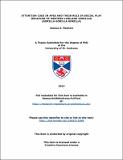Files in this item
Attention cues in apes and their role in social play behavior of western lowland gorillas (Gorilla gorilla gorilla)
Item metadata
| dc.contributor.advisor | Gómez, Juan-Carlos | |
| dc.contributor.author | Mayhew, Jessica A. | |
| dc.coverage.spatial | 271 | en_US |
| dc.date.accessioned | 2013-02-28T14:06:10Z | |
| dc.date.available | 2013-02-28T14:06:10Z | |
| dc.date.issued | 2013-06-25 | |
| dc.identifier.uri | https://hdl.handle.net/10023/3368 | |
| dc.description.abstract | The research aims of this thesis are to investigate the attention cues available to and used by apes, especially gorillas (Gorilla gorilla), to ascertain the direction of conspecific attention during social interactions with a special reference to social play. Minimal research has been conducted on the role of attention cues - eye gaze, head, and body orientation - to regulate natural social interactions, such as social play, in non-human primates. This thesis begins with an investigation of the "cooperative eye hypothesis", which poses that humans have evolved a unique white sclera adaptation for advertising and detecting gaze direction. Chapter 2 reports the existence of a natural white sclera variation in a proportion of gorilla eyes - contradicting the widely held assumption that white sclera is an exclusively human characteristic - and analyzes the presence of white sclera in relation to other morphological changes in the human eye. The study concludes that the morphological elongation of the eye might be a more important and unique change than the white sclera coloration. Chapter 3 experimentally explores the contribution of white sclera in both great ape and human eye gaze to the perception of gaze direction detection by human observers. This chapter concludes that although white sclera contributes to the accuracy and speed of gaze direction detection (an assumption that this thesis has put to experimental test for the first time), this merely adds to the already efficient gaze cues available in the eye areas of the ape face. Chapter 4 investigates the role of eye gaze, head, and body orientations during gorilla social play behavior, and more specifically, introduces a novel analysis of "vigilance periods" (VPs), in which gorillas may use the interaction between attention cues to gauge the attention and intentions of play partners to successfully navigate play. The final study (Chapter 5) complements Chapter 4 and investigates the role of gorilla postures, behaviors, and movements during changes in attentional cue orientations. This chapter concludes that gorillas often engage in physical rest during VPs but maintain attentional engagement and can assemble and impart socially relevant information based on the behaviors, movements, and attention orientations of their partner. Together, these studies suggest that attention orientation is conveyed and assessed by gorillas through a variety of interacting cues to navigate and modify social play interactions. | en_US |
| dc.language.iso | en | en_US |
| dc.publisher | University of St Andrews | |
| dc.rights | Creative Commons Attribution-NonCommercial-NoDerivs 3.0 Unported | |
| dc.rights.uri | http://creativecommons.org/licenses/by-nc-nd/3.0/ | |
| dc.subject | Western lowland gorilla | en_US |
| dc.subject | Attention | en_US |
| dc.subject | Social play | en_US |
| dc.subject | White sclera | en_US |
| dc.subject.lcc | QL737.P96M28 | |
| dc.subject.lcsh | Gorilla--Behavior | en_US |
| dc.subject.lcsh | Attention | en_US |
| dc.subject.lcsh | Play behavior in animals | en_US |
| dc.subject.lcsh | Sclera | en_US |
| dc.title | Attention cues in apes and their role in social play behavior of western lowland gorillas (Gorilla gorilla gorilla) | en_US |
| dc.type | Thesis | en_US |
| dc.type.qualificationlevel | Doctoral | en_US |
| dc.type.qualificationname | PhD Doctor of Philosophy | en_US |
| dc.publisher.institution | The University of St Andrews | en_US |
| dc.publisher.department | School of Psychology | en_US |
This item appears in the following Collection(s)
Except where otherwise noted within the work, this item's licence for re-use is described as Creative Commons Attribution-NonCommercial-NoDerivs 3.0 Unported
Items in the St Andrews Research Repository are protected by copyright, with all rights reserved, unless otherwise indicated.


